Home
A comprehensive resource for safe and responsible laser use
UK: Reports of UFO over Coventry turns out to be light show laser
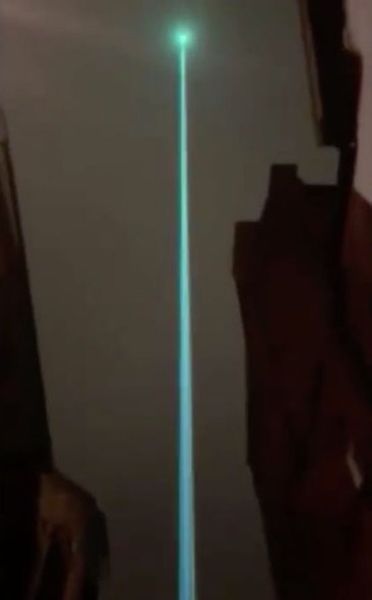
The blue-green shaft of light was from a laser said to be "the world's most powerful display laser." According to Mat Lawrence from the laser company Kvant, advance notice had been made to the U.K. Civil Aviation Authority before the test was done.
Lawrence said the beam could be seen from 20 miles away.

From The Star and Coventry Live
South Africa: 70+ laser incidents reported in 2018
In one case at at O.R. Tambo, Africa's busiest airport, "a commercial airliner on final approach to touchdown had to perform a go-around after a laser was directed at the eyes of the flight crew."
Two men in Bloemfontein were recently arrested for aiming lasers at helicopters. According to the story, "[a]s far as can be ascertained only one arrest has previously been made for shining a laser," which happened during the 2010 FIFA Soccer World Cup in Durban.
The New Age Online reported "Both the Civil Aviation Authority (CAA) and Airline Pilots Association of SA (ALPA) have spoken out strongly against the practice, which carries a maximum sentence of 30 years in jail…. ALPA general manager Sonia Ferreira said members were increasingly reporting incidents of 'sudden and intense bursts of light, deliberately shone at aircraft in and around airports'."
From the New Age. The article first appeared online May 14 2019.
UK: Average of 50 laser illuminations of military aircraft per year in UK
It is not clear if these military incidents are included in the Civil Aviation Authority (CAA) statistics about laser illuminations of aircraft.
The Ministry of Defence figures, made public June 11 2018, were rounded to the nearest 10. The list below shows the reported military-related laser incidents in the UK, along with the CAA numbers for the UK and for overseas UK operators
2013 - 40 military, 1396 CAA UK home, 329 CAA UK overseas operators
2014 - 70 military, 1447 CAA UK home, 317 CAA UK overseas operators
2015 - 70 military, 1440 CAA UK home, 355 CAA UK overseas operators
2016 - 30 military, 1258 CAA UK home, 274 CAA UK overseas operators
2017 - 40 military, 989 CAA UK home, 243 CAA UK overseas operators
The information was released in response to a written parliamentary question submitted by former defence minister Kevan Jones, who said “New laws to deter those stupid enough to carry out these attacks might not be enough, and the Government should give police operating around air bases the resources needed to catch offenders.”
From the Mirror. We have additional statistics and stories about the UK, plus a page with statistics about the UK and other countries.
UK: New UK law provides stronger penalties, easier prosecution for aiming a laser at a vehicle
The penalties for violations are up to five years imprisonment and an unlimited fine; these penalties take effect starting July 10 2018.
The law applies to laser beams aimed at aircraft, motor vehicles, trains, ships, hovercraft and other vehicles. A vehicle does not have to be moving at the time of offense; if the engine or motor is running then the law applies. Another provision makes it an offense to shine or direct a laser beam towards an air traffic facility, or a person providing air traffic services, under the condition where the beam dazzles or distracts, or is likely to dazzle or distract a person providing air traffic services.
The offense is a strict liability offense, meaning that prosecutors do not need to prove that the person shining the laser intended to endanger the vehicle or air traffic facility/controller. There are two defenses allowed: 1) the person had a reasonable excuse for shining the laser beam, or 2) the person did not intend to shine a laser at the vehicle/ATF/controller and exercised all due diligence to avoid doing so.
Click to read more...
New Zealand: Laser pointer/aircraft incidents increase about 11% in 2017
If this rate of 14 incidents per month holds for December, the 2017 total will be around 169. This would be an 11% increase over 2016.
The information comes from the Civil Aviation Authority which noted that most incidents occurred in metropolitan centers. The CAA deputy director of air transport and air worthiness, Mark Hughes, warned "People are not aware of the significance of it. It's sort of a lark, or a fun thing to do, not recognizing that actually they're causing a real safety issue and creating a danger for pilots and passengers…. It could cause an accident if the pilot is visually impaired at a critical phase of the flight.”
From Radio New Zealand
UK: New UK law to provide stronger penalties, easier prosecution for aiming a laser at a vehicle
The text of the bill is here. A House of Lords Summary Briefing, giving some background, is here.
Tough new penalties for misuse of lasers
People who target transport operators with laser devices could be jailed for up to 5 years under new laws designed to protect the public.
The Laser Misuse (Vehicles) Bill, which was published today (20 December 2017), will also expand the list of vehicles, beyond just planes, which it is an offence to target with lasers.
Drivers of trains and buses, captains of boats and even pilots of hovercraft will be among those protected by the new legislation.
The bill will make it easier to prosecute offenders by removing the need to prove an intention to endanger a vehicle.
And it will remove the cap on the amount offenders can be fined – which is currently limited to £2,500 – paving the way for substantial sanctions. Fines could be issued in isolation or alongside a prison sentence.
The police will also be given additional powers to catch those responsible for the misuse of lasers.
Aviation Minister, Baroness Sugg said:
“Lasers can dazzle, distract or blind those in control of a vehicle, with serious and potentially even fatal consequences.”
“The government is determined to protect pilots, captains, drivers and their passengers and take action against those who threaten their safety.”
Alongside their existing powers of arrest and the ability to search a person once arrested, officers will no longer need to establish proof of intention endanger to a vehicle, aircraft or vessel, making it easier to prosecute swiftly. It will be an offence to shine or direct a laser towards a vehicle if it dazzles or distracts the operator, if done deliberately or if reasonable precautions to avoid doing so are not taken.Click to read more...
UK: 1,258 laser/aircraft incidents in 2016, a 12.6% drop from 2015
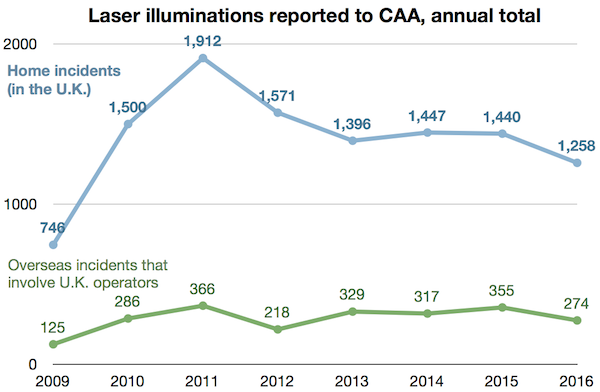
Note: Previous stories and charts elsewhere on LaserPointerSafety.com may have slightly different figures for some years. This is due to CAA updating numbers after a “SDD Coding Backlog”. The numbers above are all as reported in February 2017 by CAA.
The 1,258 home incidents in 2016 represent a 12.6% decrease from the 1,440 home incidents that occurred in 2015.
Similarly, the 274 overseas incidents in 2016 represent a 22.8% decrease from the 355 overseas incidents that occurred in 2015.
Here are the 1,258 home incidents in 2016, month-by-month:
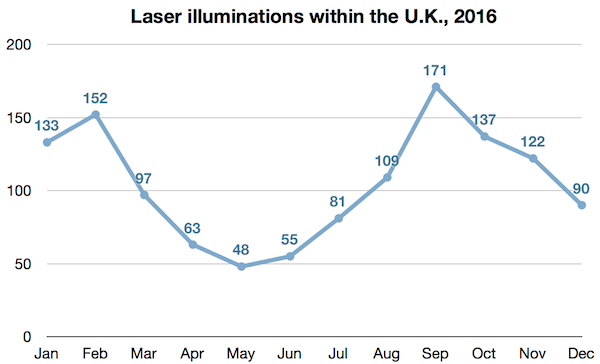
CAA listed the top 10 locations reporting laser incidents for 2016. It is not known whether these incidents all occurred at or near the indicated airports, or whether this also includes incidents (such as helicopter strikes) that occurred elsewhere but which were tallied to the closest airport.
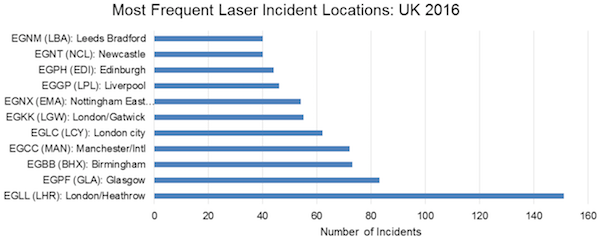
As in the United States, the majority of laser illuminations were reported to be green. The figures below are for U.K. incidents; the color distribution is roughly the same for overseas incidents as well.
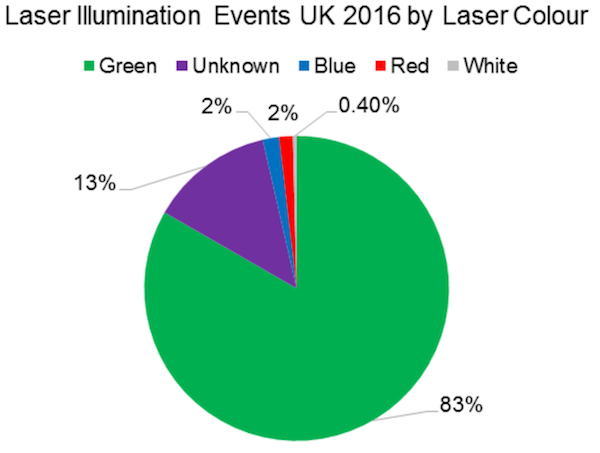
From a February 2017 report by the Civil Aviation Authority. This report contains additional details such as a monthly breakdown for each year 2009-2016, and for each of the top 10 home and overseas locations in 2016.
UK: Arrest persons carrying "high-powered" laser pointers in public, says top aviation regulator
According to Haines, laser attacks have permanently damaged pilots’ vision, and it is conceivable that they could cause an aircraft crash. In 2015 there were 1,439 laser incidents reported to CAA.
Haines said there is no legitimate reason for a person to have a high-powered laser pen in public. Press reports did not indicate Haines’ definition of “high-powered”. (In the U.K., lasers used as pointers are limited to 1 milliwatt [the U.S. limit is 5 mW], so it is possible that “high-powered” would mean any handheld laser above 1 mW.)
Haines asked “Why does Joe Bloggs walking down the street need a laser that can pop a balloon at 50 miles, that can cause permanent damage to a pilot?”
The CAA chief wants new, restrictive legislation because at present, it is difficult to find laser perpetrators and to prove they had intent to endanger aviation, under the Air Navigation Order 2009.
A U.K. government spokesperson said "We take this issue very seriously and we continue to work with other Government departments, the CAA and industry to determine how best to control the sale, use and possession of laser pens. We are looking to make changes as soon as possible."
From the Daily Mail, BBC, the Mirror, and other news sources. For commentary about Haines’ statements, click the “Read More…” link below.
Click to read more...
UK: Government department in talks to possibly withdraw high-powered lasers
The meeting is scheduled to occur during the week of February 22-26. A department spokesperson said on February 16 that it was too early to discuss any potential changes to laws.
From the Telegraph
UK: Around 9,000 laser incidents, Jan 2009 - June 2015, according to CAA
For comparison, in the United States from January 1 2009 through May 31 2015, there were 21,414 laser incidents reported to the Federal Aviation Administration. (An additional 457 incidents were reported during June 2015.) From January 1 2004 through December 31 2015 there were 29,097 laser incidents reported to FAA.
U.K. information from the Daily Mail. U.S. information from FAA data.
UK: 400+ laser incidents in the first half of 2015
From January 1 to June 30 2015, there were more than 400 laser incidents reported to CAA. Heathrow had the most incidents by count, with 48 in the first half of the year. (This is actually fewer incidents per month than last year, when there were 168 total Heathrow laser reports for all of 2014.)
By proportion of laser incidents to air traffic volume, there was a higher frequency of attacks at regional airports such as Birmingham, East Midlands, Leeds Bradford and Newcastle.
The British Airline Pilots’ Association (BALPA) on November 2015 released the results of a survey of its pilot members, showing that 50% had reported a laser/aircraft incident during the period from November 2014 to November 2015.
From the Guardian and the Express. The CAA and BALPA statistics were released along with news of a British Airways pilot who reportedly suffered severe retinal injury from a spring 2015 exposure to a “military-strength” laser.
UK: 1,442 laser incidents in 2014; up 3.4% over 2013
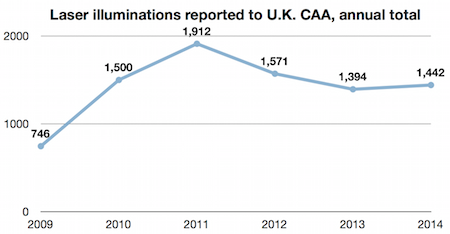
Additionally, there were 312 laser incidents that occurred outside the U.K. to U.K. operators.
In 2014, the top four most frequent incident locations were London/Heathrow (168), Manchester International (107), Birmingham (92), and Leeds Bradford (81). London/Gatwick and Glasgow were tied for fifth place, each with 64 reported incidents.
CAA published a PDF report with more detailed figures, including a monthly breakdown of the most frequent laser incident locations in 2014, and monthly & yearly totals for 2009 through 2014, and overseas (non-U.K.) incidents occurring to U.K. operators.
From the CAA PDF report dated February 2 2015. Note: There is a discrepancy where one table lists a total of 1,440 incidents in 2014 while another lists a total of 1,442. We have used the larger figure in this story.
Additional charts are on the page listing 2014 incident statistics, and the page with 2004-2014 historical data.
Norway: 100 aircraft incidents one reason for proposal to limit pointers to 1 mW
The ministry received 18 official comments by the August 8 submission deadline. According to Dagens Medisin, “none of the answers are critical [of] mitigation in the use of laser pointers.”
The ban was supported by the country’s Civil Aviation Authority (CAA), the Radiation Protection Authority (NRPA), the Police Directorate and the Customs and Excise department.
The CAA said that there were around 100 incidents each year where lasers were pointed at aircraft in Norway.
If the measure is enacted, it will take effect beginning in 2015.
From Dagens Medisin, in the original Norwegian and in English (Google machine translation). The proposal and links to comments, can be found here in Norwegian, and here in English.
UK: 1300+ laser incidents in 2013
The newspaper also reported that in the 12 months between October 2012 and September 2013, there were 31 reports of aircraft being illuminated as they approached Gatwick Airport, 30 miles south of London.
Laser strikes have also increased on rescue helicopters flying out of Redhill Aerodrome, Surrey, a few miles north of Gatwick. A tactical flight officer was quoted as saying “I've had to break away from a task because of being lasered and it's not because we're trying to catch a bad guy, it's because we're trying to find people potentially in danger.... There are certain elements of society that might be trying to harm us or put us off being in a certain location.”
Police inspector Mark Callaghan told the Mirror that there have been a number of jail terms for perpetrators, but that "Hand-held lasers are easily obtained over the internet or from market stalls and street vendors abroad. The warning labels on these are misleading and they are more powerful than advertised."
From the Surrey Mirror
UK: More than 220 laser attacks in two years in West Midlands, says CAA
This is roughly one-third of the 700 incidents over the same time frame that involved aircraft in or above the West Midlands. (The 480 non-laser incidents included bird strikes, emergency landings, a bomb threat, a dog on the runways and closure of an airfield because of a flying kite.)
On one occasion in July 2011, four different lasers were aimed at a police helicopter in a single incident.
The British Airline Pilots’ Association asked for prison sentences for persons caught aiming at aircraft, as well as regulations over the sale of high-powered lasers.”
According to West Midlands police, laser attacks on their helicopter have fallen in months prior to July 2013.
From the Birmingham Mail. See also a related LaserPointerSafety.com article on BALPA’s laser pointer suggestions.
Scotland: Pilots want stepped-up prosecution against laser attacks
An April 2013 investigation by the Scottish Express found 338 incidents in Scotland from January 1 2011 through February 13 2013. Only 12, or 3.5 percent, had been solved. The paper noted that the International Air Transport Authority (IATA) suggests there are 12 incidents involving lasers each day globally. [Note: The U.S. rate is approximately 9-10 per day, indicating the rest of the world’s rate is 2-3 per day which LaserPointerSafety.com believes to be higher.] An IATA spokesperson said the organization “support[s] strong penalties for anyone caught engaging in the act.”
The U.K.’s Civil Aviation Authority said there were 152 laser incidents at Heathrow Airport in 2012, compared with 136 incidents at Glascow Airport which has 1/10 the number of passengers.
The Scottish Express story contains additional statistics on Scotland airport lasing rates.
From the Scottish Express
UK: CAA issues Safety Notice to pilots, after 2,300 laser attacks in 2011
Below are highlights from the document, which gives some background information and statistics, and then describes how affected crew should prepare for and react to a laser attack. (Emphasis in bold added by LaserPointerSafety.com.)
Click to read more...
UK: Eye test for pilots available from CAA website
The ALESA card is available in hard copy, and can also be downloaded from CAA’s website. If downloaded, the Amsler Grid on the first page should be printed so it is 10 x 10 cm.
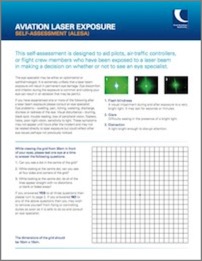
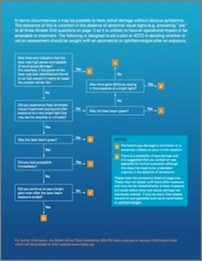
Click for PDF version from CAA ALESA webpage
When staring at the dot in the center of the grid, if the lines appear distorted or there are blank or faded areas, there may be a problem. The person is encouraged to remove themselves from aviation-related duties such as flying or air traffic control, and to see an eye specialist.
The second page has a flowchart of exposure conditions leading either to a “1” meaning unlikely eye damage or a “2” meaning eye damage possibility. If the person scores a “2”, the flowchart suggests they see an eye specialist.
From PilotWeb and the CAA ALESA webpage. The CAA press release about ALESA is here.
US & UK: UPDATED - Laser incident rate in U.K. more than twice the U.S. rate
- U.S. airports had 9,079,000 flights in 2011, with 3,591 laser incidents reported to the Federal Aviation Administration. This is a rate of one U.S. laser incident for every 2,528 flights. Said another way, this is 0.40 incidents per 1,000 flights.
- U.K. airports had 2,152,787 flights in 2011, with 1,909 laser incidents reported to the Civil Aviation Authority. This is a rate of one U.K. laser incident for every 1,128 flights. Said another way, this is 0.89 incidents per 1,000 flights.
The ratio of U.K. to U.S. rates is 2.24, meaning that the U.K. had more than twice the number of laser incidents than the U.S., when adjusted for the number of flights. (Important note: These figures do NOT mean that commercial aircraft are targeted at the rates indicated. Many laser incidents involve police helicopters. The analysis is simply meant to compare the two countries’ rates of laser misuse against aircraft of all types.)
It should also be noted that there could be many underlying factors affecting the precise numbers. For example, it is not known if the U.S. counts laser incidents in the same way as the U.K.
However, the figures do indicate that the U.K. rate of laser incidents appears to be significantly higher -- roughly twice the U.S. rate, based on the number of flights.
From an analysis by LaserPointerSafety.com, March 22 2012.
Updated May 27 2012 to correct a math error and make clear that it is the United Kingdom which has a higher rate of laser incidents (e.g., more incidents per 1000 flights). Our thanks to Brian Turner for pointing out this error.
Methodology: We define a “flight” as a takeoff plus a landing. US flight figures are from the Airline Activity “departures” statistic from the Department of Transportation’s Bureau of Transportation Statistics. It is assumed that each flight which departs also lands, so the data is accurate for “flights” as we have defined it. UK flight figures are from totaling column G, Total ATMs, from “Table 4, 1 Air Transport Movements 2011” found on the CAA UK Airport Statistics 2011 page. A UK “movement” is one takeoff plus one landing, so this is the same as our “flights” definition.
While the flight statistics compare only airline (US) and air transport (UK) flights, and do not include law enforcement flights, we believe this is a valid “apples to apples” comparison of how many more flights take place in the U.S. than in the U.K. A previous LaserPointerSafety.com analysis showed that law enforcement flights are less than 1% of the total flights from U.S. airports. Inclusion of law enforcement flight numbers would not significantly change the ratio of U.S.-to-U.K. flights.
.
UK: 1,909 laser incidents in 2011; renewed calls for laser ban or restriction
In 2011, a law was introduced by MP Greg Mulholland (Leeds North West), to make it a criminal offense to shine a laser into an aircraft cockpit.
According the Civil Aviation Authority, there were 1,909 laser incidents in the U.K. in 2011, compared with three in 2008. [Note from LaserPointerSafety.com: The 2008 statistic is almost certainly incorrect. A previous LaserPointerSafety.com news item from BBC News reported 27 lasers were used against commercial aircraft in 2007, and there were 80 cases from January through September 2008.]
From the Bradford Telegraph and Argus
South Africa: Up to 12 incidents per week, say pilots
ALPA-SA is calling for public education and a ban on handheld laser sales. According to the organization, there was a temporary drop in the number of incidents after media reports earlier in 2011, but the incidents are now on the rise again.
A spokesperson for the Civil Aviation Authority said “a few cases” had been reported thus far in 2011. He added that if the International Civil Aviation Organization introduced new regulations, the CAA would “definitely look into implementing it.”
From the Cape Argus
South Africa: 70 incidents in 2011, including a go-around; no arrests
The majority of South African incidents occurred in Cape Town, with other reports at OR Tambo, Wonderboom in Pretoria, and Lanseria International. In an incident in Lanseria, “two pilots were blinded so badly that after landing they couldn’t see the man who signaled where to park the plane” according to News24.com.
There were no persons arrested during 2011 for aiming a laser at aircraft. Over all years, there have only been two incidents resulting in arrests (as of January 11 2012):
- Around January 7-8 2012, three persons were arrested for pointing green laser beams at helicopters using the Bloemfontein civil and Air Force airports.
- During the 2010 World Cup, a man temporarily blinded a helicopter pilot in Durban
A Civil Aviation Authority spokesperson said “It is a serious hazard to point laser lights at aircraft.” The maximum penalty for an offense is a “hefty fine and up to 30 years in jail.”
The general manager of the Air Line Pilots Association of South Africa said ALPA-SA members were reporting increasing numbers of incidents where “sudden and intense bursts of light [are] deliberately shone at aircraft…”
From The New Age and DefenceWeb
Commentary from LaserPointerSafety.com: The figure of 70 incidents reported to ATNS in 2011 is probably low. A May 5 2011 news story quoted ALPA-SA as saying they receive between 10 and 12 complaints from pilots every week. That would result in 520 to 624 laser illuminations per year. Also, the 70-incident figure may be a misunderstanding or misquote. A news story from March 2011 quotes ALPA-SA as saying there were 70 incidents in the 10 months from April 1 2010 through February 28 2011; see News24.com.
.
UK: Heathrow laser incidents almost triple
From BBC News
South Africa: Incidents are increasing; pilots express concern
A representative of the Civil Aviation Authority said that laser misuse violates two sections of the Civil Aviation Regulations, and can be punished with a fine and/or imprisonment of up to 10 years. (There was an arrest in 2010 during the World Cup, when 35-year-old Yusuf Ebrahim temporarily blinded a helicopter pilot.) The CAA representative said the Authority would consider new standards or regulations if they were recommended by the International Civil Aviation Organization.
To report a laser illumination incident in South Africa, CAA said to email information to cahrs@caa.co.za or fax it to 011 545 1453.
From Independent OnLine Scitech. An IOL story about Yusuf Ebrahim’s first court appearance is here.Click to read more...
UK: Police "fight back" by tracking laser hits

1: Police helicopter is targeted by laser pointer on the ground. 2: Helicopter crew use Laser Event Recorder to locate pointer via GPS, and record its wavelength. 3: GPS details enable helicopter’s thermal (infrared) camera to find suspect, and send police patrol on the ground to arrest the person.
In addition, the UK’s Civil Aviation Authority is planning new laws prohibiting shining a laser at an aircraft. Currently, prosecutors have to prove that the laser user “recklessly or negligently endangered an aircraft”.”
BBC quotes Bob Jones, head of flight operations at the CAA: “"To those individuals targeting aircraft with laser devices the message is clear -- don't. You will be caught and you will be prosecuted and you could spend up to five years in prison. These things are not toys, they pose a serious risk to all flight safety."
Many more details, including photos and a video of a helicopter finding a laser perpetrator, are at the BBC News website.
UK: Growing concern over laser pointers
The pilot, who was over Stockport at the time, was temporarily blinded. Unable to read his instruments, he had to make dangerous emergency manoeuvres.
This case highlights a growing concern about the inappropriate use of more powerful green laser pens or pointers.
Britain's largest pilots union BALPA has recently warned of a major air disaster unless action is taken.
Click to read more...